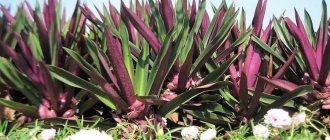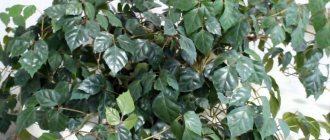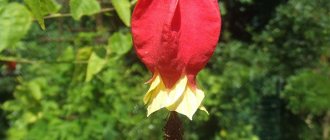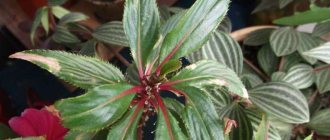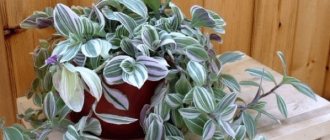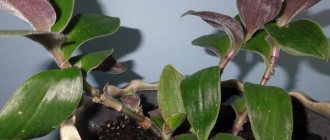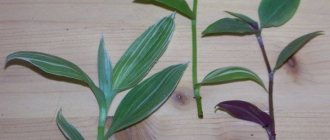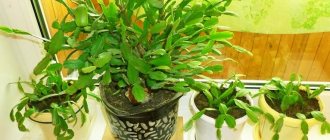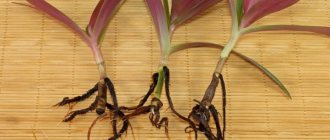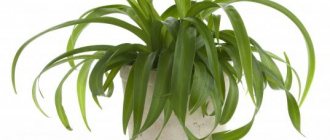Magical and healing properties of Tradescantia. Growing Tradescantia at home
Tradescantia is part of the usual circle of cute, unpretentious plants (zebrina, chlorophytum, sansevieria, etc.), which have accompanied us since early childhood: in our parents' house, in kindergarten, in the school classroom, in a variety of institutions.
And no wonder: these plants are invariably healthy and attractive even with minimal care. And now you can still find plants from this modest circle, but, unfortunately, much less often. These “modest” plants have been replaced by more spectacular and beautifully flowering (but at the same time more demanding to care for) plants.
Tradescantia received the popular name “woman's gossip” for its stems, which hang down and intertwine so that they are difficult to separate from each other.
The magic and benefits of Tradescantia
Tradescantia protects its owners well from gossip and from malignant diseases. If a person begins to have similar problems, it takes away the negative energy, dries up and dies.
Tradescantia is a universal remedy for the evil eye. Get a Tradescantia, under its influence evil people will forget the way to your home.
Tradescantia is a source of joy and inspiration. It can charge you with energy, sharpen your sense of humor, and give hope. Among other things, it protects its owners from upper respiratory tract diseases.
Neutralizes envy, brings a feeling of joy, helps to survive unpleasant moments.
All Tradescantia belong to the airy Gemini, ruled by Mercury, the planet closest to the Sun. Mercury is an air planet. The air becomes warm and light with the participation of the fiery element of the Sun, which is why Mercury follows the Sun on its heels. The sun is a planet of great joy, strong, real feelings.
Tradescantia is useful to have in homes whose inhabitants have problems with the lungs, bronchi or arms. Tradescantia has a warming effect on these organs.
Tradescantia easily reproduces, grows very quickly and contains a complex of nutrients and medicinal substances, so they are often grown to feed indoor birds, turtles, hamsters, cats and other pets. Aquarists place a pot of young Tradescantia on glass lying on the sides of the aquarium, and the growing stems of the plant soon sink into the water and form a beautiful green mat on its surface. In addition, many fish are not averse to eating these delicate leaves.
Tradescantia purifies and humidifies the air in the room, neutralizes electromagnetic radiation. A person admiring its lush greenery relieves eye strain, quickly improves his mood and makes breathing easier.
Cats intuitively sense the usefulness of Tradescantia and happily chew its shoots and juicy leaves. So if there is a cat in your apartment, the plant will have to be protected from it by giving it a small amount of leaves as “living vitamins.”
The healing properties of Tradescantia
The healing properties of Tradescantia were discovered many centuries ago: it was grown for medicinal purposes in Buddhist monasteries in Asia and Latin America.
Most often, its leaves were used externally to heal wounds, like plantain in our country. But it is known that in some countries preparations from Tradescantia were taken orally: in Cuba - for infections of the gastrointestinal tract, colitis, gastritis, flatulence, in Venezuela - for diabetes, in Jamaica - for tuberculosis.
Tradescantia has long taken its rightful place in folk medicine, because its preparations have many medicinal properties: antimicrobial, anti-inflammatory, hemostatic, wound healing, carminative, antidiabetic. Tradescantia can also be used in the treatment of serious infectious diseases such as pulmonary tuberculosis. Shoots with leaves are used - both fresh and dried.
Tradescantia. Home care
Until recently, Tradescantia grew in almost every home, which is not surprising - Tradescantia is one of the easiest indoor plants to maintain, so even the laziest gardener can make friends with this plant.
Tradescantia is an unpretentious plant. It can be in the shadows or in the light. The temperature where it grows can also be different - from warm to cool. The only thing that the flower does not like is to be watered often.
Temperature. Moderate, optimal 24-26 °C. The winter minimum is 10-12 °C, although in the historical homeland temperatures drop even lower, to almost 2-4 °C.
Lighting. Tradescantia is considered undemanding to light, but this only applies to plants with dark green leaves. All variegated varieties and varieties are light-loving; it is advisable for them to receive a certain amount of direct sunlight (eastern or western window).
Watering. Quite abundant from spring to autumn - the soil should be slightly moist all the time, without excessive dampness; in winter, when the temperature drops, watering is more moderate. The soil needs to be loosened periodically to avoid rotting.
Fertilizer . From March to August, feed with fertilizer for indoor decorative foliage plants every two to three weeks.
Air humidity . Tradescantias love very humid air, optimally about 60%. Unfortunately, they often try to compensate for the lack of high humidity with abundant frequent watering, which is completely wrong. In nature, Tradescantia is a ground cover plant with an exclusively superficial root system. In apartments, Tradescantia especially suffers during the winter heating season.
Transplant . The soil for Tradescantia should be very loose, at the same time nutritious, rich in organic matter. pH - 5.5-6.5 or slightly acidic. Forest peat soil (3 parts) mixed with sand (1 part) is perfect. You can buy universal soil in the store, add 1 part vermiculite and 1 part sand to 3 parts of it. There must be good drainage at the bottom of the pot. The pots themselves are preferably wide but shallow; several plants are planted in one pot.
Reproduction . Taken from stem cuttings in spring, summer or fall, they root well within a week or two.
Growing problems . With age, most Tradescantia tend to become bare and lose their initially healthy appearance and dense foliage, this is genetically determined - in nature, Tradescantia is a creeping plant, it does not need to have a lush bush, it creeps and re-roots in a new place. Due to their rapid growth, annual rejuvenation by cuttings is recommended. In the spring, all branches are cut, rooted in water and replanted in fresh soil; you can plant all the cuttings in one pot, as they grew, or you can divide them. In any case, the plants quickly gain strength and become thicker and more beautiful than before. You should also remember to feed Tradescantia a month after transplantation.
Meet Tradescantia!
Tradescantia is a very unpretentious house plant that has comfortably taken root on our windowsills. Its unpretentiousness is expressed in the fact that Tradescantia can be left unwatered for a couple of weeks and nothing will happen to it. Although it should not be brought to this point, since this plant is very beautiful and no less useful.
Tradescantia grows quickly, like lightning! Being a climbing plant, it is capable of entwining an entire room with its vines in a very, very short time. Bright green leaves on the outside and purple inside harmonize very vividly with any interior and create the impression of a real jungle.
Home tradescantia was recognized as a medicinal plant by the biologist from Venezuela D. Pierro . He was able to scientifically prove that this plant has a whole set of pharmacological properties. Pirerro found a substance similar to inulin in Tradescantia juice, which can significantly lower blood sugar. Thanks to this substance, tradescantia (or rather, its juice) is now used to cure diabetes.
Also, Dr. Pirerro was able to identify a group of phytoncides that have significant antimicrobial activity and that could successfully destroy not only bacteria, but even viruses. It turned out that these phytoncides are most active in the treatment of a wide group of various infectious diseases of the gastrointestinal tract. Moreover, these phytoncides, obtained from Tradescantia, brilliantly fought against Koch's bacillus (in South America, tuberculosis at different stages is successfully treated with the juice of this medicinal plant). Periodontal disease can also be treated with Tradescantia juice.
Traditional medicine recommends many types of forms of using Tradescantia for medicinal purposes. Here are some of them: tradescantia juice , infusion of leaves, decoction, ointment, tincture of vodka (or better yet, alcohol), powder, balm and just gruel. Moreover, if you want to make juice from Tradescantia, you should remember that the medicinal properties of the juice last no more than two hours. And if you are preparing an infusion from the leaves of this medicinal plant, then you must use only clean drinking water (not from the tap, since the chlorine contained in such water will certainly destroy Tradescantia phytoncides ).
Here's how to treat sore throat and other colds with Tradescantia:
Prepare a decoction from the leaves and stems of the plant: take fifty grams of Tradescantia raw material and pour 1.5 liters of boiling water. Then boil over low heat for a couple of minutes, let it brew for two hours and filter. This decoction should be used to gargle or rinse your nose. Also, when you have a runny nose, insert tampons soaked in this decoction into your nose. It is possible to use Tradescantia juice instead of a decoction - this is considered (from the point of view of traditional medicine) the most effective method in the fight against a runny nose.
Tradescantia and diabetes mellitus . A decoction of Tradescantia is used to treat diabetes mellitus. To do this, take one hundred grams of raw material and fill it with one liter of cold drinking water (not from the tap!). Place on low heat, bring to a boil and simmer for two minutes. After this, let it brew for a couple of hours and drink half a glass three times a day before meals. At the same time, you should take Tradescantia tincture with vodka or alcohol three times a day, but after meals. You need to be treated in this way for one month, then be sure to take a break for one month and repeat the monthly course of treatment again. Alternate for six months.
It is important to remember that when you take a decoction of Tradescantia , you must constantly check your blood sugar levels.
Tradescantia also treats boils and purulent wounds. Fresh leaves of the plant should be applied to the affected skin surfaces, and this should be done with the purple side of the leaf. To prevent the leaves from falling and to stay firmly on the wound, they must be secured with an adhesive plaster or a simple bandage. Don’t forget to replace the leaves with new ones and do this every other day.
You can also squeeze juice from the stems and leaves of Tradescantia and heat it to 38 degrees in a water bath. Then take a gauze swab, soak it in this juice and apply it to boils or wounds for about a couple of hours. You need to change the bandages several times a day. When you go to bed, you can also make a similar bandage at night, but soak the tampon not with pure juice, but with a tincture diluted with water in a ratio of 1:3.
Such procedures eliminate the possibility of spread of suppuration, ulcers quickly disappear, wounds heal and boils resolve.
Fresh Tradescantia leaves are also useful for hematomas . In order for the swelling to subside, the leaves are applied to the hematoma under a plaster or bandage. During the night of such treatment, the tumor, as a rule, subsides and the hematoma is noticeably reduced.
To get rid of periodontal disease, you need to chew a Tradescantia leaf very carefully before and after eating. You can also rub the juice of this plant into your gums or even rinse your mouth with the juice. But for rinsing, the juice must first be diluted with water. These procedures must be done throughout the day.
Similar articles
see also
- Meadowsweet beneficial properties and contraindications
- Pomegranate fruit beneficial properties
- Rice beneficial properties and contraindications
- Rowan berries beneficial properties
- Aronia beneficial properties and contraindications
- Aspen bark beneficial properties and contraindications
- Beneficial properties of fats
- Horsetail: beneficial properties and contraindications
- Whitehead beneficial properties
- Dandelion officinalis beneficial properties
- Wood ash and its beneficial properties
- Beneficial properties of beet juice
- Sweet clover beneficial properties and contraindications
- Almond nut beneficial properties
- Useful properties of ground pepper
What kind of plant is this and how to care for it?
As various signs say, Tradescantia has interesting properties.
Now there are about a hundred varieties of this indoor plant; it is a product of selection and created by a famous American botanist. The plant was named after John Tradescant. It must be said that he tried a lot and ended up with an unpretentious indoor plant.
Therefore, if you want to add some greenery to your home, you can pay attention to this flower. Of course, you will need to choose the optimal variety from a number of existing ones. In general, for the most part, only the most popular varieties are grown, which are easy to care for:
- White-flowered - has white flowers, the leaves are elongated.
- Variegated - small leaves with slight pink or white tints.
- River - on each side the leaves have a different color, on one side they are green, on the other they are burgundy.
- Lodgesa - foliage can be up to twenty centimeters long, the color is more than interesting, it has silver stripes.
- Scaphoid - leaves with soft edges.
If we talk about this plant in general and its general characteristics, then Tradescantia is characterized by the presence of rather large foliage, which has a green tint, but can slightly turn into a silver or purple tint . The stems can gradually spread out of the pot; each stem bears many flowers on a small stalk.
The unpretentiousness of this plant lies in its resistance to changes in conditions . Even if the conditions are not the most favorable, the plant continues to exist, but may slightly lose its decorative properties. However, the most optimal conditions should be noted:
- In winter - the temperature can be about 12 degrees, watering is required approximately every four days.
- In summer - the temperature should be maintained at about 24 degrees, watering is required more regularly, the soil surface should always be kept moist, but excessive overwatering should be avoided.
The plant prefers plenty of light, but there is no need to expose this flower to open rays. Therefore, sometimes it is preferable to slightly shade the Tradescantia. If you want to get a more interesting flower (in terms of decorative properties), then it is useful to periodically use fertilizers, just take some kind of complex fertilizer, which is sold in flower shops.
Useful properties of the plant
Tradescantia is tolerant - it adapts to different conditions, including those unfavorable for other indoor flowers. Many small leaves work together as a small “factory” to clean and disinfect the air. In this regard, Tradescantia is no less useful than chlorophytum or syngonium.
Tradescantia spathacea can be dangerous for small pets (contains calcium oxalate). Zebrina is non-toxic.
The most advantageous placement of Tradescantia in the interior is in hanging flower pots, baskets, containers, on stands, and wall shelves. Then you can examine in detail the variegated leaves and delicate flowers. Tradescantia is “planted” in tubs in which various types of ficus, dracaena, and date palm grow. It is useful to contemplate such combinations of plants - the eyes rest, tension goes away.
Callisia fragrant is considered a medicinal plant - “indoor ginseng”. Golden mustache contains flavonoids quercetin and kaempferol, vitamins, phytohormones, and microelements. Widely used in folk medicine to improve immunity and treat many diseases.
It is easy to care for Tradescantia; it forgives irregular watering and a long absence of fertilizing. The stability and unpretentiousness of plants depends on the species and variety. Brighter lighting, timely watering and fertilization are the requirements of modern Tradescantia hybrids with patterned leaves.
Beliefs about the flower
Now let's look at what signs exist about this flower:
- The presence of this plant in the house allows you to reduce the amount of negative impact of gossip and is generally considered an excellent protector against any evil intentions. In addition, Tradescantia has the property of a kind of protective screen , which limits you from the influence of any visitors who have envious and evil thoughts.
On the other hand, some consider this plant not the best option for the home, since Tradescantia can create a mood for excessive anxiety , so you should listen to your own feelings when you start such a plant.
This plant is considered capable of clearing space from various negative entities that can inhabit the space , but in order for the plant to “work” you need to take care of this flower. If the plant feels your care, it will repay you handsomely and serve you well.
If the Tradescantia suddenly dries out, although you carry out normal watering and provide optimal conditions, then this fact may indicate that the plant has taken on damage or the evil eye , the flower has warded off the damage from you, you should thank the Tradescantia and bury it somewhere.
In addition, you can evaluate the different zones of your apartment depending on the well-being of the plant , they perfectly sense negative zones and begin to fade there, accordingly, a work area, bed or something similar should not be located in these parts of the space.
- According to some beliefs, this plant can generally have a very significant impact on the owner’s everyday life; sometimes such a plant can help you get positive changes in your own existence and achieve some results.
Care
To get lush flowering and strong foliage, it is important not to forget to care for Tradescantia. The principles of cultivation are quite simple, since the flower itself is unpretentious
Watering
The plant loves abundant watering; if there is a lack of moisture, the flowers wither, its growth stops, and in extreme cases it can dry out completely.
Top dressing
Frequently fertilizing Tradescantia is not required. Feed only the strong shoots that have appeared once and again when buds appear. Thanks to such measures, the plant will feel comfortable for a couple of years, after which mineral fertilizing can be applied again.
Diseases
This flowerbed inhabitant is not afraid of insects and is little susceptible to disease, so he does not need to apply special compounds for prevention. If, nevertheless, the leaves of this garden resident are covered with spots, then most likely he suffered from fungal diseases. In this case, the tips of the foliage become brown, a light coating may appear, and the buds sometimes change their shape to an irregular one. To get rid of this disease, you will have to use fungicides.
Wintering
To successfully survive the winter cold, it is advisable to cover the flower. Despite all its frost resistance, it needs protection. The best way to do this is with the help of autumn fallen leaves. It is placed in large quantities on top of the plants. Usually this is enough for a comfortable wintering of Tradescantia.
See below for the characteristics of Garden Tradescantia.
Can I keep it at home?
There are studies by scientists that confirm that Tradescantia has useful pharmacological properties, in particular bactericidal. Therefore, such a flower can reduce the number of various viral diseases. In addition, the plant purifies the air from various harmful impurities and reduces the impact of electromagnetic radiation.
This is a very relevant property for modern apartments, where a huge number of electrical appliances work and there is electrical wiring in almost every wall.
If you feel the influence of the evil eye or feel significant envy towards you, then it is quite important to get a Tradescantia in order to reduce such influences. Tradescantia helps create a carefree mood, adds a sense of humor and an easy attitude to reality.
If you have become overly gloomy or just want to add a little joy to your own home, you can also try this plant . Moreover, sometimes even the pleasant and interesting appearance of this flower can make your mood a little better. You will receive positive emotions.
On the other hand, climbing plants are considered a cause of concern . Tradescantia is one of those, that is, loaches.
Much depends on your individual properties and characteristics. After all, each person is unique and has their own preferences, which also affect their relationship with flowers. If you regularly take care of your Tradescantia, then, as said earlier, the flower will be grateful to you and will be able to show positive properties.
We recommend watching a video about Tradescantia:
Each species has its own signs
Currently there are more than 100 different types of Tradescantia . Researchers distinguish them by the size and shape of their leaves, color and, of course, abilities. The most popular among fans are:
Virginskaya
It usually reaches a height of 55 cm. Around mid-summer, active flowering begins with bright pink and purple buds. Famous for its ability to calm and charge you with a good mood.
Blossfeld
A lush plant with purple stems and medium-sized leaves. His energy is aimed at the owner’s career growth, well-being and accompanying luck everywhere . It is recommended to purchase such a comrade in case of loss of self-confidence and reduced self-esteem.
Zebrina
An ampelous flower with oblong green leaves, in the middle of which there are silver stripes. This species serves as one of the main protectors against rumors and the evil eye, and protects each family member from bad events and the appearance of ill-wishers.
Anderson
Externally, it is very similar to Tradescantia virginiana. However, in this case, the height of the stems reaches 85 cm, and often this variety can even be found as a garden resident. In the house where Anderson appears, relations between its inhabitants quickly begin to improve, all conflicts disappear, and everyone’s spirits rise .
By the way, this plant also knows how to attract good friends and faithful comrades.
Tradescantia Anderson Condre Grape
Setcreasia purpurea
It can be presented in several forms: erect, creeping and branched . And in each such species there will be a lilac tint to the entire above-ground part. Despite all the external beauty, such specimens must be treated with extreme care, and it is better to choose non-residential premises for its habitat .
Purple tradescantia very quickly absorbs all the surrounding negativity, and then, from an overabundance, begins to reflect it . For this reason, troubles and omissions may begin in the house.
As you already understand, each species has its own qualities and history. Will any of them become your assistant and friend?
Characteristics of the variety and types of Tradescantia with names
Tradescantia is a perennial plant characterized by flexible, long, rapidly growing stems. The fleshy sprouts bear oblong oval leaves, attached with short petioles. The flower can have a solid or variegated green color.
The surface of the leaf blades can be either smooth or fluffy. During the flowering period, which begins at different times of the year, small inflorescences appear on Tradescantia, consisting of a large number of buds. In this case, only a couple of buds can open at a time. The flowers have long stamens, delicate petals and a dark green calyx.
Among the known 75 species of Tradescantia grown at home, some varieties are especially popular and widely cultivated: although in the photo their differences may seem insignificant at first glance, when buying flowers and making floral arrangements with them, their characteristics clearly appear.
Tradescantia white-flowered is one of the most famous varieties, divided into 2 varieties, the names of which are: “Aurea” (with yellow leaves and a greenish stripe) and “Tricolor” (with a green leaf blade and lilac and white stripes). The leaves grow up to 6 cm in length and 2 cm in width. Inflorescences of small white flowers form on the shoots.
Riverside Tradescantia is a flower with many fragile purple stems raised above the ground. There are many leaves on the plant, but they are small - 2-3 cm in length. The inner side of the leaf matches the color of the stem.
Rules for caring for Tradescantia at home
Despite the fact that Tradescantia is not the most fastidious plant, novice gardeners may encounter the problem of deterioration in the appearance of the flower. The most common problems and ways to solve them:
Home care
To improve the appearance of the plant, it is necessary to tie it up and provide support if it is not growing in a hanging pot. A vertical support can be inserted into the soil in which the flower grows, and the stems can be tied with threads. For decoration and support, you can also use wall mounts: leaning on them, the Tradescantia will curl.
To help the flower acclimatize, it needs to be transplanted into new soil and fertilized. However, if Tradescantia was purchased in winter or autumn, the plant should not be replanted; it is advisable to wait until spring. If necessary, replanting can be done in winter, but then the plant must be provided with additional lighting.
Unlike some indoor flowers, which can be planted in open ground in the summer, it is not recommended to carry out such a procedure with Tradescantia. So slugs and ticks can easily grow on it, and the scorching daytime sun can burn the leaves. However, you can take the pot outside in the morning and evening, leaving it in partial shade and not forgetting to spray it.
Choosing soil and pot
The basic requirements for a substrate for tradescantia are lightness, breathability, neutrality and nutritional value. To create such soil, you can purchase plant soil in the store and mix it with natural minerals: vermiculite and agroperlite (3 parts soil, 1 part each mineral).
Such soil turns out to be loose, dries quickly and provides air flow to the root system, so that water does not stagnate in it.
The pot itself should be wide, but shallow, and must have holes for draining excess water. It is preferable to choose pots made from plastic or hardwood. You should not take a ceramic pot - the roots are easily overcooled in it.
Lighting and temperature conditions
The light in the room should be very bright, but at the same time diffused: the scorching direct rays of the sun burn the leaves of the plant. You can shade a plant standing on a brightly lit windowsill using translucent Roman blinds. You can understand that the lighting is too weak by looking at the pattern on the leaf blades: it becomes blurry, inexpressive and pale. Optimal lighting can be achieved by placing a pot of Tradescantia near a western or eastern window.
The plant can also develop in artificial light if it is not turned off for 10-12 hours.
In spring and summer, the indoor temperature should be maintained at 23-25˚C, and the flower should be taken out into the open air in warm weather. If this is not possible, the room should be ventilated 1-2 times a day, but avoid drafts. In winter, the temperature in the room must be maintained at 14-16˚C; at lower temperatures the plant dies. Ventilation during the cold season is necessary, but it should be minimal, and there should be no flows of cold air in the room. Sudden changes in temperature are also unacceptable.
Description of appearance
The photo of Tradescantia shows that outwardly this plant consists of several creeping or erect stems covered with alternately arranged leaves. The shape of the leaves depends on the species. The color can be any: green, gray, white, purple, blue, red.
Garden Tradescantia lives up to 10 years, but over time it needs to be renewed. It can reach a height of 30–60 cm. In nature, there are also meter-long specimens. Annual growth can reach 0.3 m.
The plant begins to bloom in July. Inflorescences are formed in the leaf axils on the upper parts of the shoots. Flower color is blue or blue-violet.
How to propagate and replant a flower at home
Tradescantia can be propagated in one of three main ways: cuttings, dividing the bush and sowing seeds. The first method is simple and can be used year-round. Algorithm of actions for cuttings:
- You need to separate cuttings (5-6 pieces) from an adult flower and remove the leaves on the lower internodes.
- Place the cuttings in water for 7-10 days, cover them with a bag or jar.
Cuttings
The method of dividing a bush, in turn, is the fastest and helps to obtain several adult plants at once. The method is only suitable for adults (2-3 years) and heavily grown flowers. The procedure can be carried out in the spring before transplanting the plant into a new pot.
It is necessary to loosen the soil, remove the entire bush from the pot and free the roots from the remaining lumps of earth. You can divide the bush with a knife or your hands, but this must be done quickly and carefully. The separated parts need to be planted in separate containers, watered with warm water and complex fertilizer applied to the soil.
Dividing the bush
Of the methods presented, seed propagation requires the most effort. In addition, this method sometimes leads to the loss of varietal characteristics. In order for the seeds to germinate, you need to prepare fertile soil mixed with sand. The seeds are planted in the ground, watered with warm water and covered with film. During their germination, you need to maintain a room temperature of 20˚C and bright, diffused light. The greenhouse must be regularly ventilated and the sprouts must be sprayed. Plants grown in this way can bloom in the 3rd year.
Young plants will need to be replanted every 2-3 years; older plants need to be replanted as needed. An emergency transplant is needed if the earthen ball has turned sour or the root system has grown too much.
When replanting, you need to take a pot that is slightly larger than the previous one, has holes for draining excess liquid and a drainage layer. If the old earthen ball is in normal condition, there is no need to clear the roots from it: just move the plant to a new pot and add fresh soil to it. After transplanting, the flower needs to be watered.
Reproduction and transplantation
As the flower grows, it will need to be moved to larger pots. Setcreasia should be replanted in the spring. Planting is carried out once a year for young individuals and once every two or three for adults. In the process you need to trim the shoots. The soil is suitable humus. You can make the mixture yourself or use a store-bought one. Pots with good drainage at the bottom should be used.
The plant propagates by cuttings and seeds. Features of each method:
- Seeds are propagated in spring. In March, they are sown in small greenhouses using a mixture of equal amounts of sand and peat. The temperature in the greenhouses should be approximately 20 degrees. The container must be constantly ventilated and sprayed. Seedlings bloom in the third year.
- You can pinch netcreasia with cuttings at any time of the year. The shoots are cut into pieces 10-15 cm long. The cuttings are planted in pots of 10-15 pieces. The soil is mixed from compost soil, sand and humus in equal parts. At a temperature of 10-20 degrees they take root in a few days. After a month and a half, the flower acquires a decorative appearance.
The benefits and harms of tradescantia for the home
You can grow Tradescantia at home not only for interior decoration, but also for medicinal and preventive purposes. A flower in the house serves as a kind of filter for purifying and humidifying the air, which is beneficial for the respiratory system. When used externally, the plant promotes the healing of wounds and burns, and when used internally, it helps with gastrointestinal diseases and sore throat.
There is a widespread belief that Tradescantia is an indicator of energy in a room. In places with negative energy, the flower does not take root even with good care. However, at the same time, the plant can be bred to improve relations between relatives in the house: it has a positive effect on mood and helps to avoid family quarrels.
Tradescantia is also considered to protect the home of its owners from evil intentions, envy and gossip.
If a flower suddenly dries up, despite careful care, this may be evidence that it has warded off damage or the evil eye from its owners.
Growing this flower is recommended for people who smile little, feel unhappy and depressed. It is believed that Tradescantia attracts positive emotions and helps to see happiness in simple everyday things. When caring for such a flower, carelessness develops, the sense of humor and the ability to easily endure failures improve.
The benefits of Tradescantia for the home also depend on where it is placed: it is advisable to grow it in the kitchen and office, but you should not grow it in the bedroom: the harm from it in this room is that it, like any climbing plant, can lead to loss of love between spouses.
How to get a positive effect from a flower
The first thing to remember: tradescantia is beneficial only with proper care and caring attitude towards it. This is a flower with active energy, enhancing the owner’s intentions, raising tone, accelerating vibrations. It helps to cope with a depressed state of mind, strengthens self-confidence, and stimulates action.
However, you should not approach him in an angry, irritated or disappointed mood. The plant will only increase aggressive emotions and painful sensitivity of a person.
If the owner does not have a goal or any serious aspirations, the flower will not be able to help him in any way. All discussions will remain at the level of conversations. But if you know what you want, even though you doubt yourself, Tradescantia will become the best talisman of confidence and good luck. Its energy will give you the necessary courage and faith, clarify your thoughts, charge you with optimism, and help you notice new opportunities for achieving success.
What does it mean to see a flower in a dream?
Tradescantia seen in a dream promises:
- new happy relationships with the opposite sex;
- filling life with new meaning;
- unambiguous signs of attention from the opposite sex;
- meeting with an old girlfriend or boyfriend;
- a magnificent, cheerful celebration of a wedding, name day or christening.
The only moment in the dream that should alert you is a withered plant. This means that the flower warns of upcoming unrest or trials. A difficult period is coming and you need to mentally prepare.
